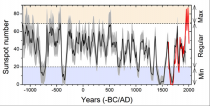Aug 11, 2014
A 3,000-Year Record of Solar Activity
CO2 Science and Jack Dini, Canada Free Press
Reference: Usoskin, I.G., Hulot, G., Gallet, Y., Roth, R., Licht, A., Joos, F., Kovaltsov, G.A., Thebault, E. and Khokhlov, A. 2014. Evidence for distinct modes of solar activity. Astronomy and Astrophysics 562: L10,
What was done
According to Usoskin et al. (2014), the Sun “shows strong variability in its magnetic activity, from Grand minima to Grand maxima, but the nature of the variability is not fully understood, mostly because of the insufficient length of the directly observed solar activity records and of uncertainties related to long-term reconstructions.” Now, however, in an attempt to overcome such uncertainties, in a Letter to the Editor published in the journal Astronomy and Astrophysics, Usoskin et al. “present the first fully adjustment-free physical reconstruction of solar activity” covering the past 3,000 years, which record allowed them “to study different modes of solar activity at an unprecedented level of detail.”
What was learned
As illustrated in the figure below, the authors report there is “remarkable agreement” among the overlapping years of their reconstruction (solid black line) and the number of sunspots recorded from direct observations since 1610 (red line). Their reconstruction of solar activity also displays several “distinct features,” including several “well-defined Grand minima of solar activity, ca. 770 BC, 350 BC, 680 AD, 1050 AD, 1310 AD, 1470 AD, and 1680 AD,” as well as “the modern Grand maximum (which occurred during solar cycles 19-22, i.e., 1950-1996),” which they describe as “a rare or even unique event, in both magnitude and duration, in the past three millennia.”

Figure 1. Reconstructed decadal average of sunspot numbers for the period 1150 BC-1950 AD (black line). The 95% confidence interval is shown by the gray shading and directly measured sunspot numbers are shown in red. The horizontal dashed lines demark the bounds of the three suggested modes (Grand Minimum, Regular, and Grand Maximum) as defined by Usoskin et al.
Further statistical analysis of their reconstruction revealed the Sun operates in three distinct modes of activity (1) a regular mode that “corresponds to moderate activity that varies in a relatively narrow band between sunspot numbers 20 and 67,: (2) a Grand minimum mode of reduced solar activity that “cannot be explained by random fluctuations of the regular mode” and which “is confirmed at a high confidence level,” and (3), a possible Grand maximum mode, but they say that “the low statistic does not allow us to firmly conclude on this, yet.”
What it means
Usoskin et al. (2014) write their results “provide important constraints for both dynamo models of Sun-like stars and investigations of possible solar influence on Earth’s climate.” They also illustrate the importance of improving the quality of such reconstructions, in light of the fact that previous reconstructions of this nature “did not reveal any clear signature of distinct modes” in solar activity.
Unfortunately, it was beyond the scope of this paper to address the potential impact of solar activity on climate. Yet the reconstruction leaves a very big question unanswered—What effect did the Grand maximum of solar activity that occurred between 1950 and 2009 have on Earth’s climate? As a “unique” and “rare” event in terms of both magnitude and duration, one would think a lot more time and effort would be spent by the IPCC and others in answering that question. Instead, IPCC scientists have conducted relatively few studies of the Sun’s influence on modern warming, assuming that the temperature influence of this rare and unique Grand maximum of solar activity, which has occurred only once in the past 3,000 years, is far inferior to the radiative power provided by the rising CO2 concentration of the Earth’s atmosphere.
Is It The Sun?
By Jack Dini August 6, 2014
We may be witnessing the sun’s last dying gasps before entering into a long slumber. The impact of that slumber on Earth’s climate remains the subject of growing scientific speculation. (1)
In 2008 William Livingston and Matthew Penn of the National Solar Observatory in Tucson, in a controversial paper that contradicted conventional wisdom and upset global warming theorists, predicted that sunspots could more or less disappear after 2015, possibly indicating the onset of another Little Ice Age. They stated, “The occurrence of prolonged periods with no sunspots is important to climate studies, since the Maunder Minimum was shown to correspond with the reduced average global temperatures on the Earth.” The Maunder Minimum lasted for approximately 70 years from about 1645 to 1715, and was marked by bitter cold, widespread crop failures, and severe human privation. (2)
There has been increasing evidence in recent years to support this supposition that global warming is linked with solar activity. In 2011, three papers suggested the Earth could be heading for a ‘little ice age’ as solar activity drops once again. (3)
Solar effects could bring on little ice ages
Other research also confirmed that solar effects could bring on little ice ages. Sarah Ineson and her colleagues report that changes in the Sun’s emissions of ultraviolet radiation coincided with observed cold winters over southern Europe and Canada between 2008 and 2011. (4)
And Katja Matthes and colleagues report that simulations with a climate model using new observations of solar vulnerability suggests a substantial influence of the Sun on the winter climate in the Northern Hemisphere. (5)
A 2014 paper by Chinese scientists reported the impact of carbon dioxide on climate change may have been overstated with solar activity giving a better explanation of changes in the Earth’s temperature. The paper found ‘a high correlation between solar activity and the Earth’s averaged surface temperature over centuries,’ suggesting that climate change is intimately linked with solar cycles rather than human activity. Indeed, the study says that the ‘modern maximum’ - a peak in solar activity that lasted much of the last century corresponds very well with an increase in global temperatures. (6)
Russian scientists foresee an even more dramatic situation. They predict that a little ice age will begin in 2014. (7)
In their book, The Neglected Sun, authors Fritz Vahrenholt and Sebastian Luning pose that temperatures could be two-tenths of a degree lower by 2030 as a result of an anemic sun, which would mean warming getting postponed far into the future.
Note that these reports are from researchers around the world.
Nick Hallet observes, “The research shows that the current warming models of the IPCC seem to underestimate the impact of natural factors on climate change, while overstating that of human activities. Solar activity is an important ingredient of natural driving forces of climate. Therefore, it is valuable to investigate the influence of solar variability on the Earth’s climate change on long time scales.” (6)
Add to all this a very recent paper that says the modern Grand maximum of the sun (which occurred during solar cycles 19-23, i. e., 1950-2009) was a ‘rare or even unique event in both magnitude and duration in the past 3,000 years.’(8) Unfortunately, it was beyond the scope of this paper to address the potential impact of solar activity on climate. Yet the reconstruction leaves a very big question unanswered - What effect did the Grand maximum have on Earth’s climate? As a ‘unique’ and ‘rare’ event in terms of both magnitude and duration, one would think a lot more time and effort would be spent by IPCC and others in answering that question. Instead, as noted earlier, IPCC scientists have conducted relatively few studies of the Sun’s influence on modern warming, assuming that the temperature influence of this rare and unique Grand maximum of solar activity, which has occurred only once in the past 3,000 years, is far inferior to the radiative power provided by the rising CO2 concentration of the Earth’s atmosphere. (9)
Lawrence Solomon sums this up well, “The upshot for scientists and world leaders should be clear, particularly since other scientists in recent years have published analyses that also indicate that global cooling could be on its way. Climate can and does change toward colder periods as well as warmer ones. Over the last 20 years, some $80 billion has been spent on research dominated by the assumption that global temperatures will rise. Very little research has investigated the consequences of the very live possibility that temperatures will plummet. Research into global cooling and its implications for the globe is long overdue.” (2)
References
1. "Sun has weakest solar max in over 200years,” the gwpf.org, December 16, 2013
2. Lawrence Solomon, “Chilling evidence,” financialpost.com, September 16, 2010
3. Lewis Page, “Earth may be headed into a mini ice age within a decade,” theregister.co.uk, June 14, 2011
4. Sarah Ineson et al., “Solar forcing of winter climate variability in the Northern Hemisphere,” Nature Geoscience, (2011), doi: 10.1038/ngeo1282
5. Katja Matthes et al., “Atmospheric science: solar cycle and climate predictions,” Nature Geoscience (2011), doi: 10.1038/ngeo1298
6. Nick Hallet, “Solar activity not CO2 could cause global warming,” breitbart.com, July 29, 2014
7. Sebastian Luning and Fritz Vahrenholt, “Will the solar doldrums of the coming decades lead to cooling? A look at the latest scientific publications,” notrickszone.com, May 10, 2014
8. I. G. Usoskin et al., “Evidence for distinct modes of solar activity,” Astronomy and Astrophysics, 562: L10, doi: 10.1051/0004-6361/201423391
9. "A 3,000 year record of solar activity,” co2science.org, August 6, 2014
Jul 31, 2014
An Incredible $7.9 Billion in enviro funding helps back the EPA’s radical agenda
Watts Up With That
Update: See more here in the Washington Examiner on The hidden persuaders of the environmental elite by Ron Arnold.
-----------
5 WAYS THE ‘BILLIONAIRES’ CLUB’ RUNS THE EPA
By Ben Shapiro
According to a new report from the United States Senate Committee on Environment and Public Works, a “club of billionaires” including Tom Steyer and Hank Paulson has effectively hijacked the Environmental Protection Agency for its own purposes to grow the EPA and regulate the economy from stem to stern.
Here are the top five takeaways from the report regarding the billionaire takeover of the EPA:
Agency “Capture.” According to the report, billionaires work with former colleagues in the non-profit sector who are specifically placed at key points within the agency. The report explains, “the Obama EPA has been deliberately staffed at the highest levels with far-left environmental activists who have worked hand-in-glove with their former colleagues.” Furthermore, the EPA sends “grants to their former employers and colleagues.”
The Revolving Door. The report reveals a huge number of EPA officials shuttling into and out of the agency and into and out of associated non-profits funded by the so-called Billionaires’ Club. These include Bob Sussman, Senior Policy Counsel at the EPA under former administrator Lisa Jackson; he came from the Center for American Progress. Other revolving door EPA staffers: Michelle DePass, former Assistant Administrator for the Office of International and Tribal Affairs, who came to her position from the Ford Foundation and actually worked for both organizations simultaneously at one point; Michael Goo, former Associate Administrator of EPA, who worked for Congressman Ed Markey (D-MA); Dr. Al Armendariz, Region 6 Administrator, who worked for the Environmental Integrity Project.
The Secret Emails. Jackson was caught using her private email address to send sensitive material, but she was hardly the only one. Sussman was caught using “his personal email to communicate with environmentalists in violation of EPA policy.” James Martin, former Region 8 Administrator, was similarly caught “using his personal email account to communicate with environmentalists...about official agency business in violation of official EPA policy.” Michael Goo, former Associate Administrator of EPA, also emailed member so the Sierra Club about how to sink Keystone XL.
The Funding. The report shows that EPA regulators have used their influence to send money back to the Billionaires’ Club charities. Grants from the EPA have totaled $3 billion over the last decade; Obama’s EPA “has given more than $27 million in taxpayer funded grants to major environmental groups.” Organizations like the American Lung Association have received $14 million since 2009, even though ALA has repeatedly sued the Agency.
Special Treatment. The report suggests that Region 2 Administrator Judith Enck violated the EPA’s standards and ethics by giving EPA grantees “special treatment.” For example, even though the activist group El Puente had been ruled out of bounds thanks to breaking the terms of its grant, Enck delayed the killing of its grant for ten months. Enck is currently under inquiry by the Office of the Inspector General. Similarly, the Louisiana Bucket Brigade (LABB, a former project of the Tides Foundation) grabbed cash from Jackson. That cash went to fighting oil and gas projects in Louisiana.
Americans have long known that the regulatory state is a complete disaster area, and that the EPA is one of the worst regulatory agencies in government. The new report confirms that fear and suggests that for all their complaints about money in politics, leftists are quite comfortable with it so long as it serves their ends.
--------------
How a Club of Billionaires and Their Foundations Control the Environmental Movement and Obama’s EPA
A new report was released today by the Senate Environment and Public Works committee, and it is damning. All this time that climate skeptics are accused of being in the employ of “big oil” is nothing more than a projection of their own greed.
Some excerpts:
Over 7.9 BILLION in funding between these groups.

Enlarged
Bill McKibben caught in a lie, he might be “scruffy” be he isn’t nearly broke as he once claimed:

Enlarged
The “epicenter” of funding disclosed:

Enlarged
The NRDC “mafia”

Enlarged
Josh wasn’t far off the mark:

Enlarged
Read the entire report here, then demand action from your legislators.
That is why Podesta and Obama/McCarthy are so aggressive on this watermelon (green on the outside red in the middle) agenda. It is the biggest fundraising scam.
-----------
See Alan Carlin’s comments on receiving the whistleblower award at the Heartland ICCC9.
My Remarks on New Proposed EPA Power Plant Regulations at ICCC9
Alan Carlin | July 18, 2014
On July 8 I received the Climate Science Whistleblower Award at the Ninth International Conference on Climate Change sponsored by the Heartland Institute and other cosponsoring organizations held in Las Vegas, Nevada. The following are remarks I prepared for my acceptance statement:
I greatly appreciate receiving this award and for the efforts of the many people involved at many levels in making the award possible. I consider it a great honor and thank you for it. I wrote my negative comments on the Endangerment Finding support document because I believed EPA was using bad science and that EPA’s proposed Endangerment Finding would be easier to stop at that stage than later. But it is very encouraging to find that others agree with my decision to do so, which EPA clearly did not.
My offending comments to EPA led to my being immediately muzzled at the same time that Obama was spinning his transparency and scientific integrity line. The Endangerment Finding was issued later that year without any of my suggested changes in the support document, of course. This finding is the legally definitive EPA statement on climate science. It has been tested in the courts and is legally no longer an issue; this is what I hoped to avoid by my challenge to the support document.
For the last few years I have been working on a book-length manuscript describing everything touched on here and much more, including my skeptic efforts, how the environmental movement lost its way since my days as a Sierra Club activist and leader, and the main legal, journalistic, governmental, scientific, environmental, and economic aspects of the climate issue. This manuscript is now complete and up-to-date. If any of you know a good way to get it published so that it will be read, please let me know since I think it has some vital messages for everyone as we approach the showdown over the proposed EPA regulations.
The Endangerment Finding led directly to EPA’s proposed regulations for reducing CO2 emissions from power plants earlier this year. The new EPA proposed regulations are even worse than I expected in 2009, perhaps because the blueprint for them was actually written by an environmental organization. First of all, they are illegal, as per any reasonable reading of Section 111(d) of the Clean Air Act. They impose many aspects of the Waxman-Markey bill despite Congress’ rejection of it, and try to force red states to adopt the usual market-distorting preferences for power generation promoted by radical environmentalists. The regulations will have major adverse effects on the US economy, all for no or more likely negative benefits, and will result in higher costs for electric ratepayers, with particularly adverse effects on lower income groups. They will also lead to potentially extremely costly electric grid instability and load shedding when electric power is most needed. EPA is effectively trying to rewrite the Clean Air Act without consulting Congress or observing the law or the Constitution.
John Boehner calls Obama’s behavior in this and other areas “aggressive unilateralism;” I call it dictatorial. Even if EPA’s science were correct, which it is not, the regulations should be rejected on the basis of EPA’s illegal power grab. I believe that skeptics need to place greater emphasis on this aspect of the situation. The powers of the Presidency have been an issue since the founding of the Republic and are much more readily understood than climate science will ever be.
So what started out as a scientific issue concerning a proposed Endangerment Finding has now escalated into a major legal and even Constitutional issue concerning Presidential powers. The President roams the country calling us “flat-earthers” and science-deniers. Perhaps it is time to characterize his behavior as illegal and even dictatorial.
Currently the public favors the EPA regulations by 67 to 29 percent so there appear to be many possible recipients for better information if we are to succeed in avoiding the future that radical environmentalists want to impose on our country through unjustified Federal intervention in still another vital sector of the economy. If their efforts should succeed, we can reasonably look forward to much higher levels of mandated CO2 reductions in this sector and probably many others as well. It is better to stop this mission creep now before it metastacizes even further.
We must not fail for the sake of the country’s economic and environmental future and the preservation of the rule of law. These new power plant regulations will happen unless a way is found to stop them. There are only three possible ways to do this: A president who will withdraw them, Republican control of both houses of Congress, or rejection by the courts. Obama will not willingly withdraw the regulations before he leaves office in 2017. Rejection by the courts has not proved a dependable strategy to date, but the proposals are becoming increasingly outrageous legally. Congress is the only somewhat dependable avenue in the near term, and there is an election in 2014. A number of environmental groups are already very hard at work trying to influence this election so as to promote their proposed EPA regulations. They have already even sent me two thinly disguised such appeals, probably because I live in a state with a Democratic senator up for reelection!
Jul 29, 2014
Introducing the Open Atmospheric Society

At the Heartland Institute ICCC9, Anthony Watts announced the launching of a new society that has been in the works for many month.
Welcome to The Open Atmospheric Society, known as “The OAS”.
We give you a voice where other societies may not.
The OAS is a international membership society for the purpose of studying, discussing, and publishing about topics in atmospheric related earth sciences, including but not limited to meteorology, hydrology, oceanography, and climatology. It is open to anyone with an interest at the associate level, but student and full memberships also are offered.
The purpose of the society is to foster quality atmospheric science and atmospheric science communications through outreach, member education, member publishing, and electronic media. We see the differences highlighted on the web site home page (http://theoas.org)
Our motto: verum in luce means “truth in the light”.
Open science - a transparent online peer review process. Publishing peer reviewer comments (not names), will illuminate the process.
Open membership - Associate members, anyone who has an interest in atmospheric science, can join at a basic rate, providing interdisciplinary membership.
Professional full members, will require a degree in atmospheric sciences or related earth disciplines, or three published papers in these subjects.
Student members get a reduced rate, similar to associate members with option to full member elevation.
Open journal - The Journal of the OAS will be free to read by the public.
Author account - each author and co-author will have accounts for collaboration, submitting papers , making edits, and responding to reviewers.
No other journal asks this upfront: strict OAS Journal submission requirements, technical submissions to the Journal by members must include all source data, software/code, procedures, and documentation to ensure reproducibility of the paper’s experiment or analysis by external reviewers.
Emphasis on reasonable publication turnaround, generally three months or less.
Press releases will be sent with each publication, author assistance is offered in preparation.
Video production assistance for authors to explain papers and post to the journal page with your paper.
Organizational activity will be conducted entirely online - This means no costly brick and mortar infrastructure, no costly postal mailings journals, and no need for warehousing paper files and publications.
Online meetings conducted via Skype for organizational purposes.
Nomination/Voting for officers and other issues conducted online.
Monthly email newsletters and special online webcasts.
To learn what The OAS is all about, go to the main page: http://theoas.org
To join, please go to The OAS Membership Portal
The initial setup of The OAS was made possible by a grant from Stephen and Dr. Mary Graves. We thank them for their foresight and generosity.
Jul 24, 2014
Get Ready for the New England Power Shortage
William Tucker, RealClearEnergy.org
Governors are already meeting in emergency session.
In 1980, under the first administration of Governor Jerry Brown, California decided it wasn’t going to build any more power plants but would follow Amory Lovins’ “soft path,” opting instead for conservation and renewable energy. By 2000, with the new digital economy sucking up electricity, a drought in the Pacific Northwest cut hydropower output and the state found itself facing the Great California Electrical Shortage.
You know what happened next. For weeks the Golden State struggled to find enough electricity to power its traffic lights. Brownouts and blackouts cascaded across the state while businesses fired up smoke-belching diesel generators to keep the lights on. Governor Gray Davis finally got booted out of office but the state didn’t rescue itself until it threw up 12,000 megawatts of new natural gas plants.
At that point California officials decided that the whole thing had been engineered by Enron and other out-of-state merchant providers and the charges and lawsuits flew. No Democrat ever learned a lesson. The state is now 60 percent dependent on natural gas for its electricity - twice the national average - and its electric bills are almost twice that of surrounding states. Industry is headed for the door.
So how have California’s liberal counterparts on the East Coast managed to avoid the same fate? You’d think a region that could produce Elizabeth Warren and Bernie Sanders plus legions of college students trained to hate fossil fuels would have no trouble pursuing the same green dreams. Well, it’s about to happen. In the next few years New England will be facing a full-scale power shortage.
Last week the governors of the six New England states met in an emergency session at Bretton Woods, New Hampshire, to discuss what to do about the pending crisis. Significantly, they asked the premiers of five of Canada’s provinces to attend. That makes sense because if the region is going to get electricity from anywhere it is probably going to be from north of the border.
In a hell-bent campaign to rid itself of any form of dirty, messy “non-renewable” energy, New England has been closing down coal and oil plants for the last decade. In 2000, 18 percent of New England’s electricity came from coal and 22 percent from oil. Today it’s 3 percent coal and 1 percent oil. Meanwhile, natural gas - the fuel that everybody loves until you have to drill for it - has risen from 15 percent to a starkly vulnerable 52 percent, just behind California.
There’s only one problem. New England doesn’t have the pipelines to bring in the gas. Nor is anyone going to allowed to build it, either. Connecticut and Massachusetts are only a short distance from eastern Pennsylvania, where fracking for natural gas has leapfrogged the Keystone State into third place for overall energy production. Yet a proposal by Sempra Energy of Houston to expand its existing pipeline from Stony Point, New York, has already met fierce resistance from people who want nothing more to do with fossil fuels and construction is highly unlikely.
It’s not as if it’s not needed. Last winter, when record low temperatures hit, there just wasn’t enough gas to go around. Utilities that service home heating have long-term contracts and get first dibs. You can’t stockpile gas the way you stockpile coal, so power plant operators were left bidding against each other for what was left. Prices skyrocketed from $4 per mBTU to an unbelievable $79 per mBTU and electricity prices spiked to ten times their normal level. Just to put things in perspective, during the first four months of last winter, New England spent $5.1 billion on electricity. In the whole of 2012, it had spent only $5.2 billion.
And that’s just the beginning. New England is now limping along with 33,000 megawatts of electrical capacity, which barely meets its needs. At one auction last winter, the New England Independent Systems Operator, which manages the grid, came up 145 megawatts short - an almost unheard of occurrence. Yet in the next two years the region will be closing down 1/10th of its capacity in a bid to rid itself of anything that does not win favor with environmentalists. First to go will be the last of four coal plants at Salem Harbor, which can no longer meet the EPA’s new regulatory requirements. Next Brayton Point, the largest remaining coal plant, will be retired for the same reason. Finally, a continual barrage of protests and legislative attacks has persuaded Mississippi-based Entergy to close the Vermont Yankee Nuclear Station and “let the Yankees freeze in the dark,” as they used to say in Texas and Louisiana. The reactor provided 75 percent of Vermont’s electricity and 4 percent of the power for the region, carbon-free.
“It’s going to be very tricky for New England over the next three to four years” says Gordon van Welie, CEO of the Independent Systems Operator of New England, which run the grid. Van Welie begged the region not to close down Vermont Yankee and Brayton Point, but who listens to anyone who understands electricity anymore? Interestingly, New England only got through last winter by regularly importing 1,400 megawatts from Indian Point, the two nuclear plants on the Hudson in neighboring New York. Says New Hampshire energy consultant William P. Short III, “Without Indian Point, New England would have been toast.” As you might expect, New York Governor Andrew Cuomo and most of the state’s Democratic politicians are trying to close down Indian Point as well.
Naturally, all this is falling hardest on people who hold blue-collar jobs. The Gorham Paper and Tissue Company in New Hampshire was forced to reduce production and lay off workers in the depths of last winter. The Great Northern Paper Co. in Maine laid off 200 workers and closed down for four months. In fact, if you want to know why we have “income inequality” and a “disappearing middle class,” look no further than the class warfare being waged on American industry by upper-educated elites snugly ensconced in the digital economy or sitting in Washington writing regulations telling everybody else what to do. “We’re going to have an economy that operates only nine months of the year,” complains Maine Governor Paul LePage, the only Republican in the region.
So where will New England be getting its electricity? Almost daily the newspapers are filled with stories about how the region is “going green” and about to enter the delightful world of “clean energy.” It’s sheer fantasy. No one has the slightest notion of what it would entail. You would have to cover half of the Green Mountains with windmills to recover the power lost at Vermont Yankee and even then it would only work when the wind is blowing. Almost as soon as the news came about the closing of Vermont Yankee, one company proposed building a power plant that burned wood in the wilds of western Massachusetts. However, someone soon discovered that burning wood produces smoke and carbon dioxide as well. It was quickly shouted down. It’s probably just as well. At one point Massachusetts drew up plans to harvest wood for electricity and discovered it would soon strip the state of its forests.
So the only “clean energy” left in New England these days is hydroelectricity - generated in Canada. The Canadians are indeed developing huge dams in James Bay and are eager to sell to Americans. But that means building transmission lines down from the north and everyone is opposed to that as well. Northeast Utilities, which services much of New England, has been trying to build a Northern Pass transmission corridor since 2009 but environmental groups insist the lines be buried underground. Two documentary films - a standard item these days - have already been made opposing the project. Meanwhile, environmentalists have become so ambitious and well funded that they have bought up land and property rights in northern New Hampshire just to block its path. Plans to bury just eight miles of the 187-mile route have ballooned costs from $200 million to $1.4 billion and the project is years from completion - if ever.
So what is likely to happen? Another cold winter is certain to bring skyrocketing prices and possible brownouts. New Englanders already pay 45 percent higher electric bills than the rest of the country and that figure can only grow. The first region of the country to industrialize is about the drive away the last of its blue-collar workshops.
One thing the region will not run short of, however, is political bluster. When the New England States Committee on Electricity (NESCOE) tried to broker a deal to have ratepayers finance a collectively owned gas pipeline, the volunteer organization was lambasted for “conspiring with industry to produce profits” and “failing to consider all the renewable alternatives.” When the crisis finally arrives this winter or next, you can be sure Vermont’s socialist Senator Bernie Sanders will be at the head of the pack, braying that the whole thing has been caused by “speculators.” Or bad planning by power companies - never bad policies by politicians or the EPA, aka the Employment Prevention Agency.
Jul 21, 2014
Joe Bastardi: Media Just ‘Want to Be Popular’ on Climate Change
Joe Bastardi
Climate alarmists sometimes like to claim skeptical scientists don’t exist, but they do, and one meteorologist had a lot to say on the subject.
In an interview with the MRC’s Business and Media Institute, well-known meteorologist Joe Bastardi dissected and criticized major aspects of the climate change alarmism movement. Drawing on his knowledge of weather and climate history, Bastardi said that “extreme weather” events the media talk about so much are commonplace and the result of normal variability. He also attacked basic arguments about CO2, scientific consensus and alarmist media bias.
Bastardi contended that climate alarmism is “ludicrous” and “not about science.” He didn’t mince words, blasting climate alarmists as living in a “loony world.” He also criticized news media that “simply follow what the majority thinks because they want to be popular” instead of understanding the issue.
After many years working with AccuWeather, Bastardi is now a weather forecaster for Weatherbell Analytics LLC, where he is tasked with making accurate and objective forecasts for private sector clients. He has appeared on many news broadcasts, including Fox News, CBS and ABC.
Bastardi specializes in understanding the history of weather and climate and said he used this understanding to accurately predict both Hurricane Sandy and Hurricane Arthur ahead of official warnings. In contrast, he said alarmists “don’t know what happened yesterday” or “know anything about what happened in the past.”
As Bastardi pointed out, he has to make accurate predictions in order to be paid and has no political motivation.
Bastardi asserted that alarmist scientists cannot actually be objective, because they are given grants explicitly to study global warming. He called upon alarmists to answer just one question. “What would it take for you to change? What do you need to see?” If this question cannot be answered, he argued, then there is nothing empirical behind their arguments that man is causing catastrophic climate change.
Addressing the science, Bastardi noted the entire world only adds 1.8 ppm of CO2 in a year, he called the notion that this miniscule amount causes extreme weather “ludicrous.” Instead, he said alarmists are just “taking every weather event they can find” and connecting it to climate change. He urged people to ask themselves if they believe that amount of carbon dioxide could have the impact that climate alarmists claim it does.
He also criticized the so-called consensus of alarm among climate scientists, saying “it is easy to have consensus when someone will pay you to have one.” Bastardi was very firm in the belief that the climate movement was “not about science” but had become a movement “from people who make profits” off the hysteria.
In his view, the alarmists’ goal was the “restructuring of the way our society works,” and the consequences if their economic recommendations are adopted are “suicide for our way of life.” Furthermore, he pointed out that the United States alone cannot make an impact on global emissions, as it releases only 10 percent of the world’s carbon dioxide. He joked “What are we going to do? Go to war with the rest of the globe [and force them to cut emissions?”
|









